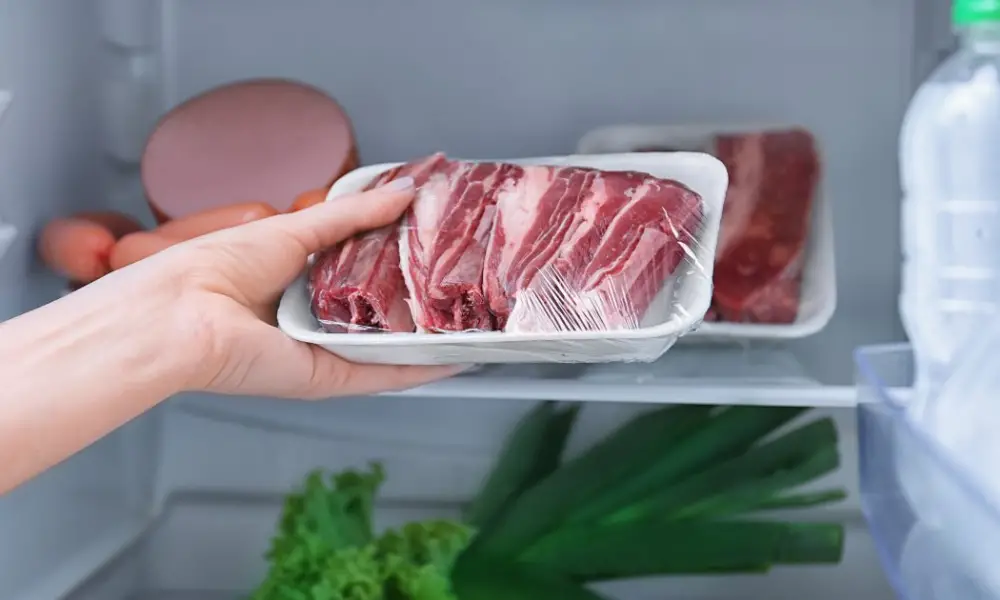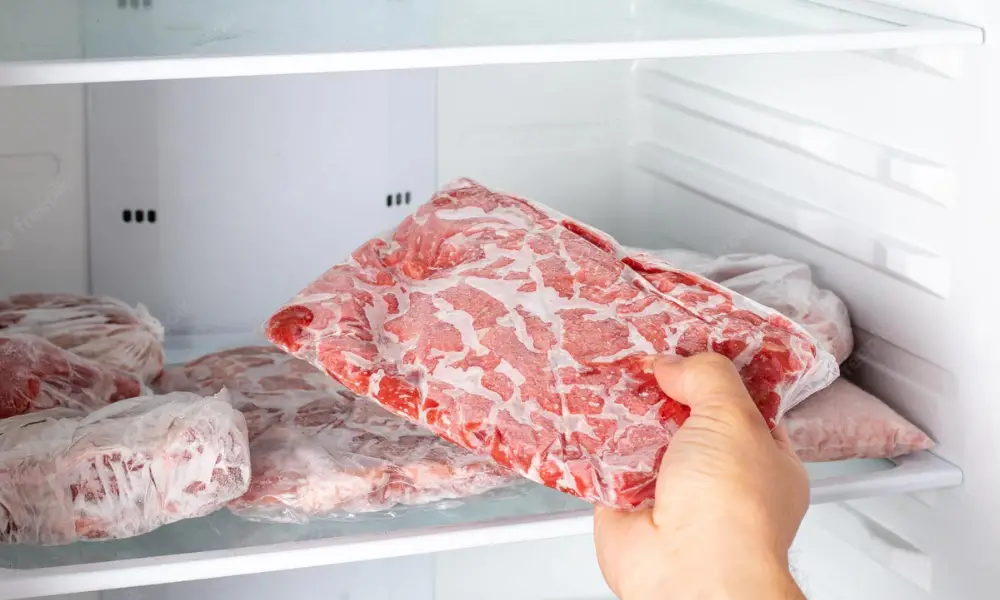The Centers for Disease Control and Prevention advise storing appliance thermometers in the refrigerator and freezer to help minimize food loss during a power outage. The freezer and the refrigerator should be kept at or below freezing points of 40 and 0 degrees, respectively.
You are in luck if you are looking for ways to keep your meat fresh in a power outage. Here are some tips on ensuring that your freezer can keep your food safe for up to two days without power.

How Long will Meat Last in Freezer Without Power?
Food in a refrigerator will remain safe for up to 4 hours if the doors are closed. 48 hours in a fully-stocked freezer and 24 hours in a partially-stocked freezer.
When it comes to storms and power outages, the utilities are not always on your side. But they are certainly not helpless. Utility companies have elaborate plans in place to restore electricity in a safe and timely manner.
After four hours without electricity or a cold source like dry ice, toss out perishable items in your refrigerator, including meat and other food products like seafood, cut fruits and vegetables, eggs, milk, and leftovers.
Verify the temperature of any food kept in coolers or a refrigerator with an additional cold source. Food that has reached a temperature of 40 degrees should be discarded.
Check to ensure that the appliance thermometer in your freezer is still set to 40 °F or lower.
Food thawed at 40 degrees Fahrenheit or lower with ice crystals can be safely refrozen or cooked.
How Long will Freezer Remain Cool?
According to Tamika Sims, Ph.D., senior director of food technology communications at the International Food Information Council, a refrigerator will probably maintain a safe temperature if the door is kept closed for up to four hours in the absence of power.
When your freezer is half full or full, the food keeps it cool for almost 48 hours or about a day. The freezer maintains its frigid temperature longer when more food is within than when there is less food.
But resist the need to check on your food frequently. Food spoils more quickly when the refrigerator or freezer is opened than when the doors are closed because opening them speeds up the temperature rise.
Dr. Sims advised keeping the refrigerator and freezer doors closed during power outages to preserve the frigid temperature.
How can you Keep your Freezer Cold Without Electricity?
No matter how much you want to open the doors after the electricity has gone out, the most crucial advice is to keep them locked! Insulation is a feature of refrigerators. When you open a freezer or refrigerator, warm air will rush in as cold air rushes out, substantially raising the temperature.
If you don’t prepare your refrigerator in advance, you must immediately take action.
Suppose your freezer is not filled when the power goes out. In that case, Barbara Brown, an associate professor of nutritional sciences at Oklahoma State University, suggests putting packages of food together as soon as possible so they can keep each other cool.
“When you do that, divide meat and poultry, so they are underneath other dishes. In this way, if they begin to thaw, their fluids won’t spill onto meals that are ready to eat. Just be sure to shut the freezer or refrigerator quickly.
Place the food into the coolers after four hours, or store the ice you’ve made in the refrigerator to keep it cold until the power is restored. Although it would seem logical, the FSIS advises against keeping food outside during a snowstorm. Why? Your food might come into contact with animals, changing external temperatures, humidity, sunshine, and other dirty components.
You can always cook a feast, set up a mini-blackout party, and light candles.
How Much Power does a Freezer Use?
Wattage is used to rate generators. The wattage of a medium-sized refrigerator at 120 volts ranges from 360 to 600 watts. While a sizable refrigerator would consume 750 watts or 6.8 amps at 120 volts.
An ordinary refrigerator can draw up to 13.2 amps during startup before the compressor ramps up. As a result, the generator needs to be appropriately scaled to manage the inrush current. The appliance will be harmed if the generator struggles to supply the correct voltages and cannot handle the inrush current.
Therefore, a medium refrigerator requires a minimum generator of 2000 watts, while a big refrigerator requires one of 3000 watts. Size certainly matters when it comes to generators; the bigger, the better.
What Precautions should you Take to preserve food during a Power Outage?
The only option you have when the power goes out unexpectedly is to shut the doors to your freezer and refrigerator and wait for it to come back on so you may consume the perishables.
You may know there is a chance of losing power at other times, such as before a hurricane or winter storm.
In these situations, use the following suggestions to help keep perishable food chilled:
Purchase a lot of non-perishable food. Because of this, you won’t need to use your freezer or refrigerator during a power outage.
Keep a thermometer in both your refrigerator and freezer. Perishable items should be safe in your refrigerator for four hours, in a half-full freezer for 24 hours, and in a full freezer for 48 hours. These times are estimates. If you also open your refrigerator or freezer, they become less credible.
The most accurate method for verifying whether your food is safe during a power outage is to use an appliance thermometer as a reference.
Fill your freezer with food. A full freezer can keep food at a safe temperature for twice as long as a half-full freezer. Consider putting perishable items from your refrigerator in your freezer instead of in a refrigerator without power, which will also assist in extending the period you can survive.
Put a lot of ice in a cooler. Use a thermometer to check that the cooler doesn’t grow any hotter than 40 degrees Fahrenheit, and add ice as needed. If the electricity is still out after four hours, transfer any perishable items in your refrigerator to an insulated cooler loaded with lots of ice.
How will I Know When Food in My Fridge Starts to Go Bad?
You can check the safety of your food during a power outage using the appliance thermometers inside your freezer and refrigerator.
Dr. Sims stated that the freezer should typically be at 0 degrees Fahrenheit and the refrigerator should typically be at 40 degrees F or below. You can use a food thermometer on the individual products to assess whether they are safe to consume if the appliance does not have a thermometer inside to measure the temperature.
You can’t always rely on your senses to evaluate food safety, even though some items, like dairy products and meats, may start to appear or smell terrible.
Dr. Sims stated, “Items in the freezer should have an interior temperature below 40 degrees Fahrenheit in order to be safe to refreeze or prepare for ingestion.” “Meats, eggs, and leftovers should be thrown out if they have been above 40 degrees Fahrenheit for more than two hours.”
The Food Safety and Inspection Service (FSIS) offers a simple guide outlining when to discard certain food groups if you’re unsure whether to keep or throw away your food.
For instance, throw out lunch meat, soft cheese, milk, and yogurt right away if the temperature has been above 40 degrees Fahrenheit for more than two hours. However, in that situation, you are still allowed to keep hard cheese, butter, margarine, uncut fresh fruit, and breakfast items like waffles and pancakes.
Always err on the side of caution, Dr. Sims warned. Therefore, it is best to throw away any food in your refrigerator or freezer during a power outage—or at any other time, for that matter—if you are doubtful about its safety and instead rely on pantry items that can be stored on shelves.
But assuming their temperatures guarantee their safety, it is advisable to consume perishable items—including leftovers, meat, poultry, and foods containing milk, soft cheese, cream, or sour cream—in your refrigerator first.
What are the Side Effects of Consuming Meat that has Gone Bad After the Power Cut?
You can determine whether your meat is safe to consume by checking the temperature inside your refrigerator. Any meat refrigerated and left out above 40 degrees for more than four hours runs the risk of developing bacteria that leads to foodborne disease. You must always avoid tasting perishable items to determine whether they are ruined.
The Food and Drug Administration (FDA) lists the following as signs of foodborne disease, which commonly manifest one to three days after consuming infected food:
- Vomiting
- Diarrhea
- Body aches and pains, particularly in the vicinity of the abdomen
- Fever
- Headache
People who consume tainted food and contract a foodborne illness typically bounce back quickly. You should see a doctor as soon as possible if you experience severe symptoms like dehydration.
Conclusion
The utilities are not always on your side regarding storms and power disruptions. However, they are in no way powerless. In truth, utility companies have well-thought-out plans to restore power quickly and safely.
After four hours without electricity or a cold source like dry ice, throw away perishable things in your refrigerator, such as meat, seafood, cut fruits and vegetables, eggs, milk, and leftovers. Any food in coolers or a refrigerator with an additional cold source should have its temperature checked. Food that has gotten to a temperature of 40 degrees or higher needs to be thrown out.
